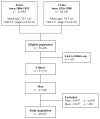Occupational exposure in parkinsonian disorders: a 43-year prospective cohort study in men
- PMID: 21733735
- PMCID: PMC3200471
- DOI: 10.1016/j.parkreldis.2011.06.009
Occupational exposure in parkinsonian disorders: a 43-year prospective cohort study in men
Abstract
Background: Several occupations and occupational exposures have been investigated for associations with Parkinson's disease. Common findings are increased risk associated with pesticide exposure and no association between Parkinson's disease and welding.
Methods: We explored the association between a broad range of possible occupational risk factors and Parkinson's disease as well as Parkinson's disease plus other forms of Parkinsonism (referred to as Parkinsonian disorders), using prospectively collected data in the population-based Swedish Twin Registry. A cohort of 14,169 Swedish men was followed for up to 43 years. We identified 234 Parkinsonian disorder cases including 204 Parkinson's disease cases with complete data. We assessed exposure to 14 chemical and biological compounds through a job exposure matrix. Hazard ratios (HR) with 95% confidence intervals (CI) adjusted for age, smoking, and education were used to estimate the relative risk of disease associated with exposure.
Results: Exposure to inorganic dust was associated with increased risk of Parkinson's disease and Parkinsonian disorders, HR 1.6 (95% CI 1.1-2.4) and 1.5 (1.0-2.2) respectively. There was no association between Parkinson's disease or Parkinsonian disorders and occupational exposure to pesticides, welding smoke, metal dust, wood dust, animal handling, stone and concrete dust, chrome and nickel dust, quartz dust, organic dust, oil, asbestos, organic solvents and irritating gas.
Conclusions: Inorganic dust should be explored further as a potential risk factor for Parkinson's disease. Occupational exposure to pesticides and twelve other compounds explored in this study may not be associated with risk of Parkinson's disease in Swedish men.
Copyright © 2011 Elsevier Ltd. All rights reserved.
Figures

Similar articles
-
Occupational exposures and head and neck cancers among Swedish construction workers.Scand J Work Environ Health. 2006 Aug;32(4):270-5. doi: 10.5271/sjweh.1010. Scand J Work Environ Health. 2006. PMID: 16932824
-
Occupational particle exposure and chronic kidney disease: a cohort study in Swedish construction workers.Occup Environ Med. 2024 Jun 3;81(5):238-243. doi: 10.1136/oemed-2023-109371. Occup Environ Med. 2024. PMID: 38811167 Free PMC article.
-
Parkinsonism and occupational exposure to pesticides.Occup Environ Med. 2001 Sep;58(9):582-9. doi: 10.1136/oem.58.9.582. Occup Environ Med. 2001. PMID: 11511745 Free PMC article.
-
Is electric arc welding linked to manganism or Parkinson's disease?Toxicol Rev. 2005;24(4):237-57. doi: 10.2165/00139709-200524040-00004. Toxicol Rev. 2005. PMID: 16499406 Review.
-
Occupational exposures estimated by a population specific job exposure matrix and 25 year incidence rate of chronic nonspecific lung disease (CNSLD): the Zutphen Study.Eur Respir J. 1994 Jun;7(6):1048-55. Eur Respir J. 1994. PMID: 7925872 Review.
Cited by
-
Use of job-exposure matrices to estimate occupational exposure to pesticides: A review.J Expo Sci Environ Epidemiol. 2017 Mar;27(2):125-140. doi: 10.1038/jes.2016.25. Epub 2016 May 18. J Expo Sci Environ Epidemiol. 2017. PMID: 27189257 Review.
-
Solvents and Parkinson disease: a systematic review of toxicological and epidemiological evidence.Toxicol Appl Pharmacol. 2013 Feb 1;266(3):345-55. doi: 10.1016/j.taap.2012.11.016. Epub 2012 Dec 7. Toxicol Appl Pharmacol. 2013. PMID: 23220449 Free PMC article.
-
Cu(II) promotes amyloid pore formation.Biochem Biophys Res Commun. 2015 Aug 14;464(1):342-7. doi: 10.1016/j.bbrc.2015.06.156. Epub 2015 Jun 28. Biochem Biophys Res Commun. 2015. PMID: 26129772 Free PMC article.
-
Complex of EGCG with Cu(II) Suppresses Amyloid Aggregation and Cu(II)-Induced Cytotoxicity of α-Synuclein.Molecules. 2019 Aug 14;24(16):2940. doi: 10.3390/molecules24162940. Molecules. 2019. PMID: 31416122 Free PMC article.
-
Solvent exposed occupations and risk of Parkinson disease in Finland.Clin Park Relat Disord. 2021 Apr 20;4:100092. doi: 10.1016/j.prdoa.2021.100092. eCollection 2021. Clin Park Relat Disord. 2021. PMID: 34316670 Free PMC article.
References
-
- de Lau LM, Breteler MM. Epidemiology of Parkinson’s disease. Lancet Neurol. 2006;5:525–35. - PubMed
-
- Frigerio R, Elbaz A, Sanft KR, Peterson BJ, Bower JH, Ahlskog JE, et al. Education and occupations preceding Parkinson disease: a population-based case-control study. Neurology. 2005;65:1575–83. - PubMed
-
- Goldman SM, Tanner CM, Olanow CW, Watts RL, Field RD, Langston JW. Occupation and parkinsonism in three movement disorders clinics. Neurology. 2005;65:1430–5. - PubMed
-
- Li X, Sundquist J, Sundquist K. Socioeconomic and occupational groups and Parkinson’s disease: a nationwide study based on hospitalizations in Sweden. Int Arch Occup Environ Health. 2009;82:235–41. - PubMed
-
- Fall PA, Fredrikson M, Axelson O, Granerus AK. Nutritional and occupational factors influencing the risk of Parkinson’s disease: a case-control study in southeastern Sweden. Mov Disord. 1999;14:28–37. - PubMed
Publication types
MeSH terms
Substances
Grants and funding
LinkOut - more resources
Full Text Sources
Medical

